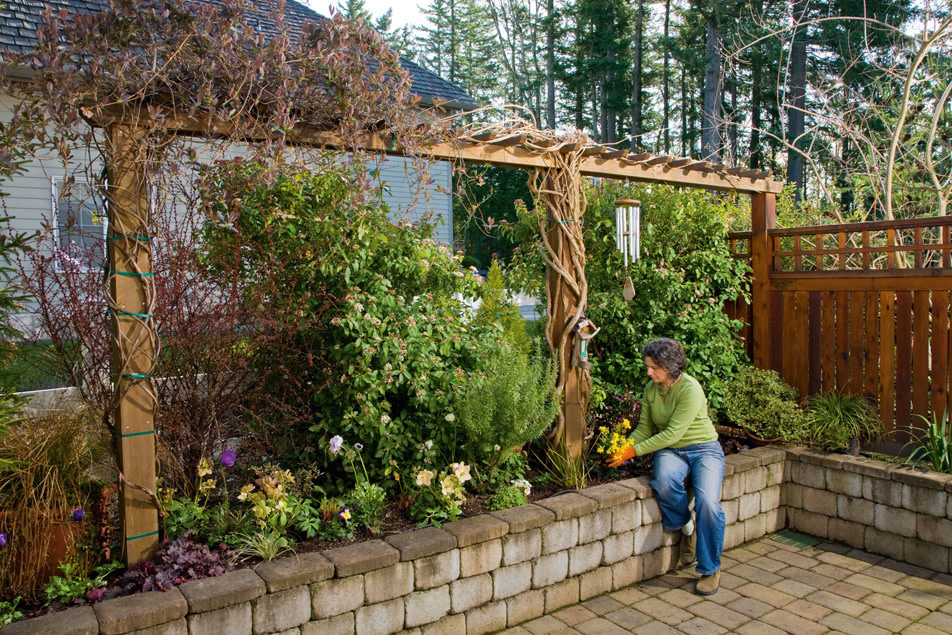Planting Privacy

Image: Steven Scardina
Taking a walk through Bill and Patty Long’s backyard in Portland’s Bethany neighborhood is a lesson in space management. The 15-by-20-foot sunken garden packs a big punch with its arbor, patio for outdoor dining, and diverse garden beds that attract and hold the attention of guests. Here, the Longs have hosted wedding receptions, cocktail parties, and festive neighborhood barbecues.
The postage-stamp-sized yard does have its limitations, though—most notably, a lack of privacy from neighbors and the residential street. But fences and privacy walls can be imposing and give a small, otherwise inviting yard an institutional feel. To keep the setting serene, the Longs enlisted the help of garden designer Amy Whitworth of Plan-it Earth Design (503-239-0105, plan-it-earthdesign.com) to create a living wall (also called a privacy planting) that would border the garden beds with softer, more colorful lines than a standard wood fence.
The result is a private backyard garden with character and an earthy, open feel. If you follow these steps, you too can create a living wall that provides privacy without boxing in your tiny yard.
{page break}

Image: Jen Davison Wick
Create a Backbone
A traditional hedge is a common way to create privacy, but it tends to lack contrast and textural variation. Instead, delineate a private space by planting groups of larger, more unusual plants, which will grow to create a living wall around the perimeter of your yard. Whitworth suggests using conifers and broadleaf evergreens as the main structure, then adding support with deciduous trees and shrubs, ornamental grasses, and fast-growing perennials. A few of her favorite choices are evergreen viburnums and California wild lilac (Ceanothus) coupled with variegated maiden grass (Miscanthus sinensis ‘Variegatus’) and porcupine grass (Miscanthus sinensis ‘Strictus’).
Big, thick plants may seem like the perfect solution for privacy, but can actually take up too much space in petite yards. “In a small space like the Longs’, we layered instead,” Whitworth says. “I chose plants whose shapes interlock, like an arching plant with a narrow base underplanted with evergreen mounding grass or culinary herbs to provide the solid cover.”
Whitworth suggests pairing a burgundy rosy glow barberry (Berberis thunbergii ‘Rosy Glow’) with shade-loving plants like hellebores.
It’s also important to create year-round interest in a garden by combining plants that interact well. Deciduous plants (those that shed their leaves with the changing seasons) might seem counterintuitive when designing a private space, but they provide a much-needed textural break from evergreens and can become points of interest in winter, especially if they have winter buds, bark, or berries, or if they have an eye-catching shape. Try red osier dogwood (Cornus sericea), star magnolia (Magnolia stellata), and burning bush (Euonymus alatus).
Most of the plants that Whitworth suggests for privacy plantings can be found at Portland Nursery (multiple locations, portlandnursery.com). The selection, size, and price will all range widely depending on your choice of plants and the time of year.
{page break}
Consider Existing Structures
Don’t be afraid to take advantage of your neighbors’ terrain as well. “Existing structures are part of a space’s borrowed landscape,” says Whitworth. “Plants of a particular size, color, or texture belonging to the neighbors can be used to make your yard seem larger, without end.”
For example, large plants and trees bordering a neighbor’s property can be co-opted into yours to add another, taller layer to your living wall, as if they were an intentional element of your backdrop. And if you’re lucky enough to have a yard bordering an attractive neighboring fence or arbor, you can incorporate these existing visual elements as accents in your own space.
But you’ll also need to consider existing structures of the less pleasing sort, like the Longs’ neighbor’s white vinyl fence. It held little appeal, so they used it to divide the space, strategically placing plants like purple-leafed heavenly bamboo (Nandina domestica) and golden oriental spruce (Picea orientalis ‘Skylands’) in front of the fence to camouflage it.
Add Detail
Privacy plantings are always more appealing when texture, color, and finishing touches are attended to. In the Longs’ yard, Whitworth added an arbor in front of the living wall to keep guests focused on the garden’s details. “The [Longs’] arbor actually makes the neighboring house seem smaller. It probably seems like a strange place for [the arbor], right in front of all the other plants, but it was a way to minimize the impact of the house,” says Whitworth.
Flowering vines like honeysuckle and trumpet vine can also stagger and soften the garden’s lines and keep the eye focused on details instead of the lack of square footage. Garden art, like an unobtrusive sculpture, will promote interest and provide a small visual break in the plantings. But make sure you select art and sculptures with an understated color scheme—they will bring out the best in the existing color palette of your new privacy planting.
By heeding little details like these, the Longs’ living wall now serves the exact purpose they’d hoped it would. “In our desire for privacy, we wanted a natural and interesting plant-filled area,” says Patty, who, along with Bill, has found their living wall far more appealing than any vinyl or wood fence could have been. “We love the variety of plants and always look forward to their blooms as the season progresses.”
